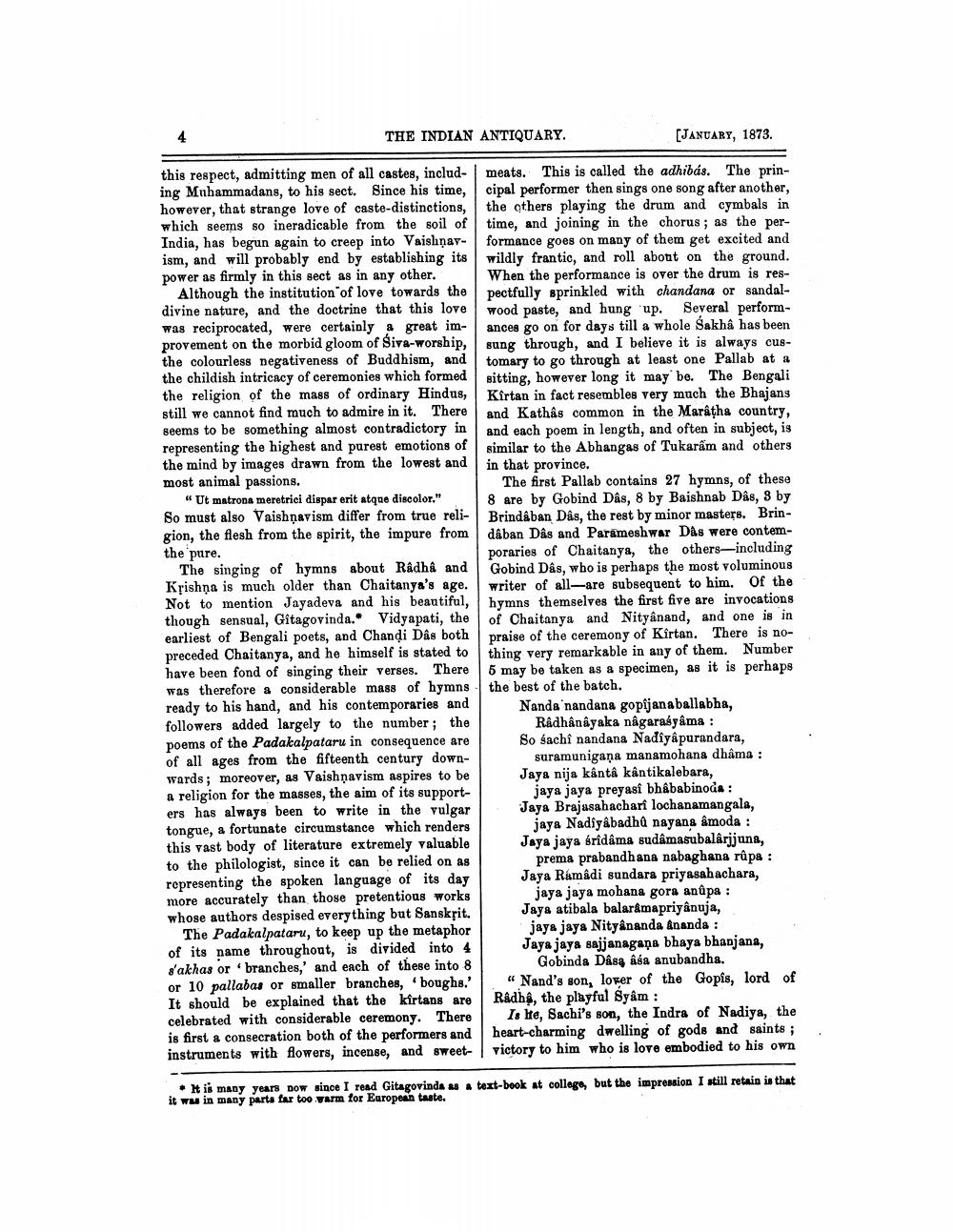________________
4
THE INDIAN ANTIQUARY.
this respect, admitting men of all castes, including Muhammadans, to his sect. Since his time, however, that strange love of caste-distinctions, which seems so ineradicable from the soil of India, has begun again to creep into Vaishnavism, and will probably end by establishing its power as firmly in this sect as in any other.
Although the institution of love towards the divine nature, and the doctrine that this love was reciprocated, were certainly a great improvement on the morbid gloom of Siva-worship, the colourless negativeness of Buddhism, and the childish intricacy of ceremonies which formed the religion of the mass of ordinary Hindus, still we cannot find much to admire in it. There seems to be something almost contradictory in representing the highest and purest emotions of the mind by images drawn from the lowest and most animal passions.
"Ut matrona meretrici dispar erit atque discolor." So must also Vaishnavism differ from true religion, the flesh from the spirit, the impure from the pure.
[JANUARY, 1873.
meats. This is called the adhibás. The principal performer then sings one song after another, the others playing the drum and cymbals in time, and joining in the chorus; as the performance goes on many of them get excited and wildly frantic, and roll about on the ground. When the performance is over the drum is respectfully sprinkled with chandana or sandalwood paste, and hung up. Several performances go on for days till a whole Śakhâ has been sung through, and I believe it is always customary to go through at least one Pallab at a sitting, however long it may be. The Bengali Kirtan in fact resembles very much the Bhajans and Kathâs common in the Maratha country, and each poem in length, and often in subject, is similar to the Abhangas of Tukaram and others in that province.
The singing of hymns about Râdha and Krishna is much older than Chaitanya's age. Not to mention Jayadeva and his beautiful, though sensual, Gitagovinda. Vidyapati, the earliest of Bengali poets, and Chandi Dâs both preceded Chaitanya, and he himself is stated to have been fond of singing their verses. There was therefore a considerable mass of hymns ready to his hand, and his contemporaries and followers added largely to the number; the poems of the Padakalpataru in consequence are of all ages from the fifteenth century downwards; moreover, as Vaishnavism aspires to be a religion for the masses, the aim of its supporters has always been to write in the vulgar tongue, a fortunate circumstance which renders this vast body of literature extremely valuable to the philologist, since it can be relied on as representing the spoken language of its day more accurately than those pretentious works whose authors despised everything but Sanskrit.
The Padakalpataru, to keep up the metaphor of its name throughout, is divided into 4 s'akhas or branches,' and each of these into 8 or 10 pallabas or smaller branches, 'boughs." It should be explained that the kirtans are celebrated with considerable ceremony. There is first a consecration both of the performers and instruments with flowers, incense, and sweet
The first Pallab contains 27 hymns, of these 8 are by Gobind Dâs, 8 by Baishnab Dâs, 3 by Brindaban Dâs, the rest by minor masters. Brindâban Dâs and Parameshwar Dâs were contemporaries of Chaitanya, the others-including Gobind Dâs, who is perhaps the most voluminous writer of all-are subsequent to him. Of the hymns themselves the first five are invocations of Chaitanya and Nityânand, and one is in praise of the ceremony of Kirtan. There is nothing very remarkable in any of them. Number 5 may be taken as a specimen, as it is perhaps the best of the batch.
Nanda nandana gopijanaballabha, Râdhânâyaka nângaradyâma : So sachi nandana Nadiyâpurandara, suramunigana manamohana dhâma : Jaya nija kântâ kântikalebara,
jaya jaya preyasî bhâbabinoda: Jaya Brajasahacharf lochanamangala, jaya Nadiyâbadhû nayana âmoda: Jaya jaya śridâma sudâmasubalârjjuna, prema prabandhana nabaghana râpa : Jaya Ramâdi sundara priyasahachara, jaya jaya mohana gora anûpa: Jaya atibala balaramapriyânuja, jaya jaya Nityananda ananda: Jaya jaya sajanagaga bhaya bhanjana, Gobinda Dâsa âsa anubandha.
"Nand's son, lover of the Gopis, lord of Radha, the playful Syâm:
Is Hte, Sachi's son, the Indra of Nadiya, the heart-charming dwelling of gods and saints; victory to him who is love embodied to his own
It is many years now since I read Gitagovinda as a text-book at college, but the impression I still retain is that it was in many parts far too warm for European taste.




